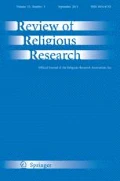Abstract
Background
Nearly half of all pregnancies in the U.S. are unintended. Unintended pregnancy refers to a mistimed or unwanted pregnancy. Unwanted and mistimed pregnancies are often distinguished from each other because of the negative social connotations and poorer health outcomes associated with unwanted pregnancies. However, mistimed pregnancies also pose significant economic, societal, and health burdens that necessitate enhanced risk factor identification and prevention efforts.
Purpose
Religion and religious practices are important to consider as potential risk factors for mistimed pregnancy as over 70% of Americans identify as religious. However, little research exists on the potential religious factors-mistimed pregnancy association. The purpose of this study was to evaluate this association among women using contraception in the U.S.
Methods
This analysis used National Survey of Family Growth data. Women (n = 2841) self-reported measures of religion, religiosity and pregnancy timing. Logistic regression was used to obtain odds ratios (ORs) and 95% confidence intervals.
Results
After adjustment, women who reported currently being Catholic, Protestant, or another religion had statistically significant increased odds of mistimed pregnancy compared to women with no current religious affiliation (Catholic OR = 2.31, Protestant OR = 1.41, Other OR = 2.58). Women who reported that religion was very important or somewhat important had statistically significant increased odds of mistimed pregnancy (Very Important OR = 1.82, Somewhat Important OR = 1.60). More frequent service attendance was associated with statistically significant decreased odds of mistimed pregnancy. Specifically, women who reported attending services 2–3 times a month or 1 or more times per week had nearly half the odds of mistimed pregnancy compared to women who never attended services (OR = 0.54 and OR = 0.51).
Conclusions and Implications
This study provides insight into the interrelationship of religion as a sociocultural risk factor for mistimed pregnancy and found that while religiously active women had increased odds of mistimed pregnancy, frequency of service attendance was a protective factor against mistimed pregnancy. Given that approximately half of pregnancies in the U.S. are unintended, additional studies are needed to further understand cultural mechanisms that may be important risk factors of unintended pregnancy, and to confirm this study’s findings.
References
Centers for Disease Control and Prevention. 2016a. National center for health statistics: national survey of family growth. Retrieved from https://www.cdc.gov/nchs/nsfg/about_nsfg.htm.
Cooperman, A., G. Smith, and K. Ritchey. 2015. America’s changing religious landscape. Pew Research Center. Retrieved from https://www.pewforum.org/2015/05/12/americas-changing-religious-landscape/#factors-behind-the-changes-in-americans-religious-identification.
D’Angelo, D.V., B.C. Gilbert, R.W. Rochat, J.S. Santelli, and J.M. Herold. 2004. Differences between mistimed and unwanted pregnancies among women who have live births. Perspectives on Sexual and Reproductive health 36 (5): 192–197.
Finer, L.B., and M.R. Zolna. 2016. Declines in unintended pregnancy in the United States, 2008–2011. New England Journal of Medicine 374 (9): 843–852.
Guzzo, K.B., and S.R. Hayford. 2014. Revisiting retrospective reporting of first-birth intendedness. Maternal Child Health Journal. 18 (9): 2141–2147. https://doi.org/10.1007/s10995-014-1462-7.
Hayford, S.R., and S.P. Morgan. 2008. Religiosity and fertility in the United States: the role of fertility intentions. Social Forces 86 (3): 1163–1188.
Hodge, D.R., P. Cardenas, and H. Montoya. 2001. Substance use: spirituality and religious participation as protective factors among rural youths. National Association of Social Workers 25 (3): 153–161.
Huber, L.R.B., J.E. Lyerly, K.E. Farley, and T. Alkhazraji. 2013. Identifying women at risk of unintended pregnancy: a comparison of two pregnancy readiness measures. Annals of Epidemiology 23 (7): 441–443.
Kost, K., D.J. Landry, and J.E. Darroch. 1998. Predicting maternal behaviors during pregnancy: does intention status matter? Family Planning Perspectives 30: 79–88.
Kramer, M., C. Hogue, and L. Gaydos. 2007. Noncontracepting behavior among women at risk for unintended pregnancy: what’s religion got to do with it? Annals of Epidemiology 17 (5): 327–334.
Logan, C., E. Holcombe, J. Manlove, and S. Ryan. 2007. The consequences of unintended childbearing. Washington, DC: Child Trends and National Campaign to Prevent Teen Pregnancy 28: 142–151.
Maldonado, G., and S. Greenland. 1993. Simulation study of confounder-selection strategies. American Journal of Epidemiology 138 (11): 923–936.
Perry, S., and C. Schleifer. 2018. Are the faithful becoming less fruitful? The decline of conservative protestant fertility and the growing importance of religious practice and belief in childbearing in the US. Social Science Research 78: 137–155.
Quinn, D.A., and A. Lewin. 2019. Family religiosity, parental monitoring, and emerging adults’ sexual behavior. Religions 10 (2): 114.
Regnerus, M.D., and C. Smith. 2005. Selection effects in studies of religious influence. Review of Religious Research 47: 23–50.
Santelli, J., R. Rochat, K. Hatfield-Timajchy, B.C. Gilbert, K. Curtis, R. Cabral, J.S. Hirsch, L. Schieve, and Unintended Pregnancy Working Group. 2003. The measurement and meaning of unintended pregnancy. Perspectives on Sexual and Reproductive Health 35: 94–101.
Sonfield, A., and K. Kost. 2015. Public costs from unintended pregnancies and the role of public insurance programs in paying for pregnancy-related care. National and State Estimates for 2010: 2015.
Speidel, J., C. Harper, and C. Shields. 2008. The potential of long-acting reversible contraception to decrease unintended pregnancy Contraception. 78 (3): 197–200. https://doi.org/10.1016/j.contraception.2008.06.001.
Wildsmith, E., K.B. Guzzo, and S.R. Hayford. 2010. Repeat unintended, unwanted and seriously mistimed childbearing in the United States. Perspectives on Sexual and Reproductive Health 42 (1): 14–22.
Williams, L., J. Abma, and L.J. Piccinino. 1999. The correspondence between intention to avoid childbearing and subsequent fertility: a prospective analysis. Family Planning Perspectives 31: 220–227.
Zhang, L. 2008. Religious affiliation, religiosity, and male and female fertility. Demographic Research 18 (8): 233–262.
Author information
Authors and Affiliations
Corresponding author
Additional information
Publisher's Note
Springer Nature remains neutral with regard to jurisdictional claims in published maps and institutional affiliations.
Rights and permissions
About this article
Cite this article
Langley, R., Bably, M., Siebens, R. et al. Does Religion Affect Perception of Pregnancy Timing among Women Using Contraception?. Rev Relig Res 63, 287–301 (2021). https://doi.org/10.1007/s13644-021-00444-3
Received:
Accepted:
Published:
Issue Date:
DOI: https://doi.org/10.1007/s13644-021-00444-3

